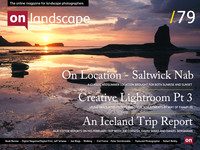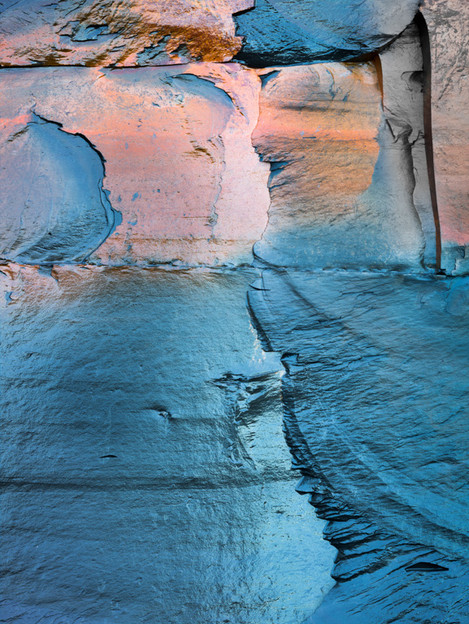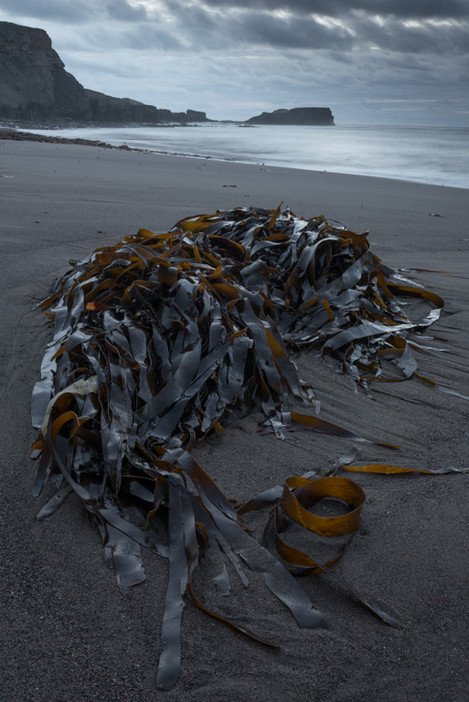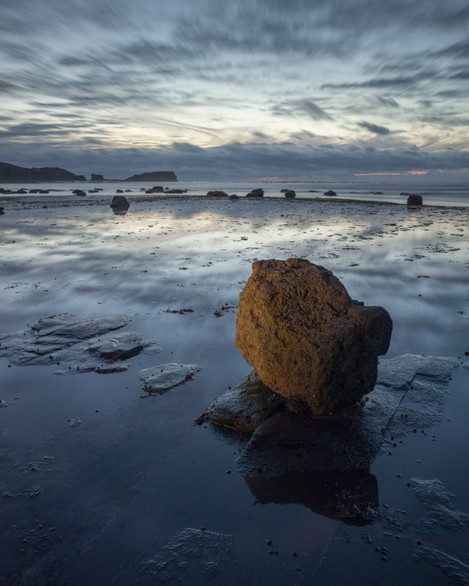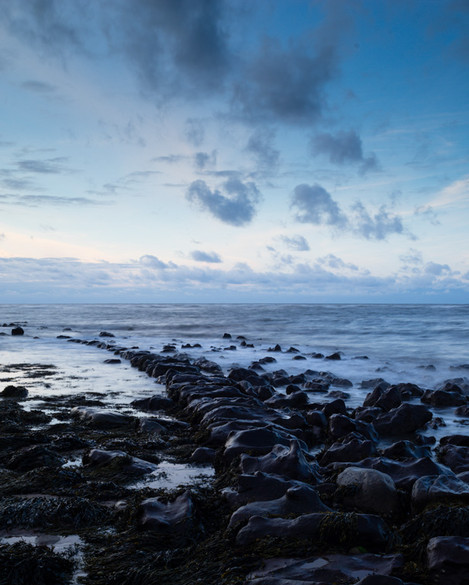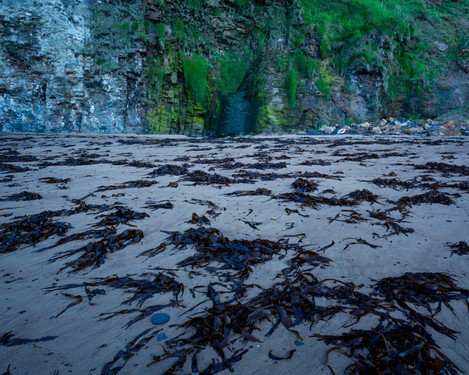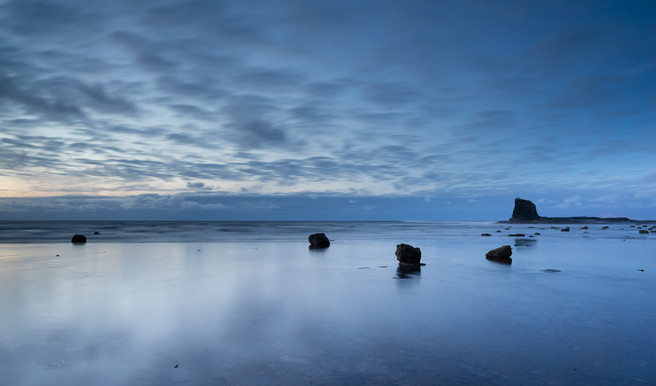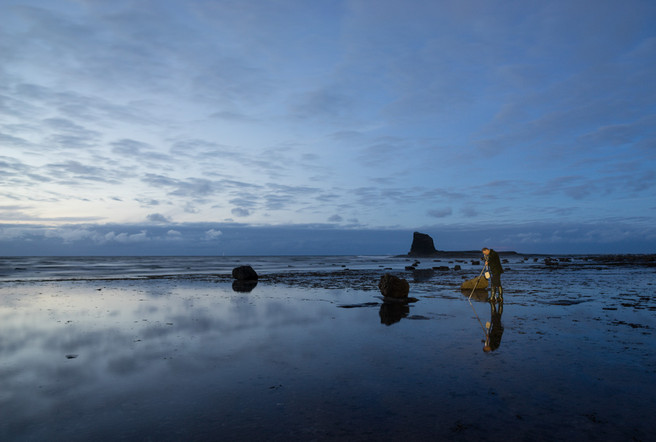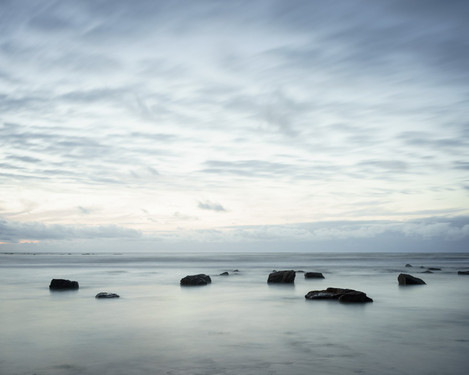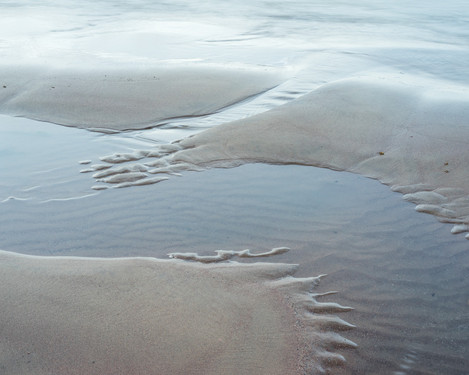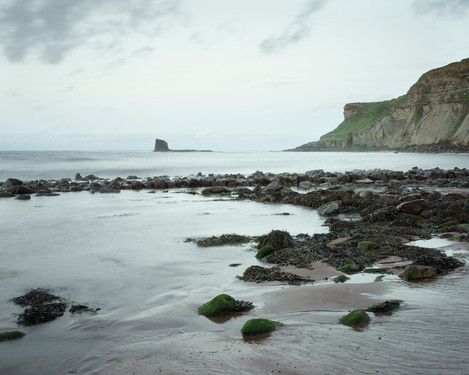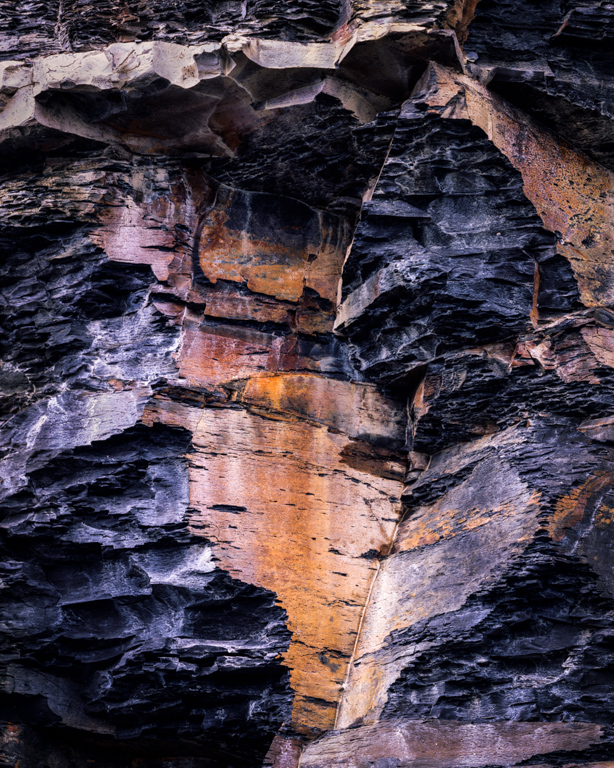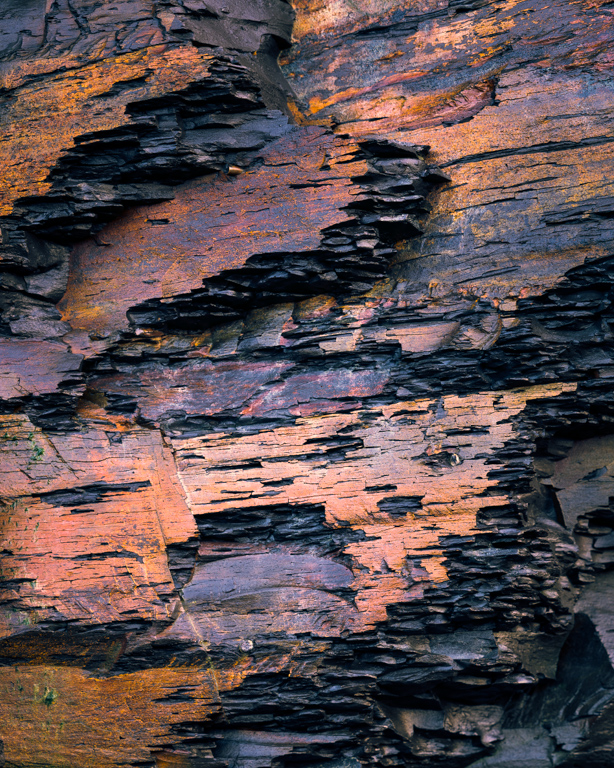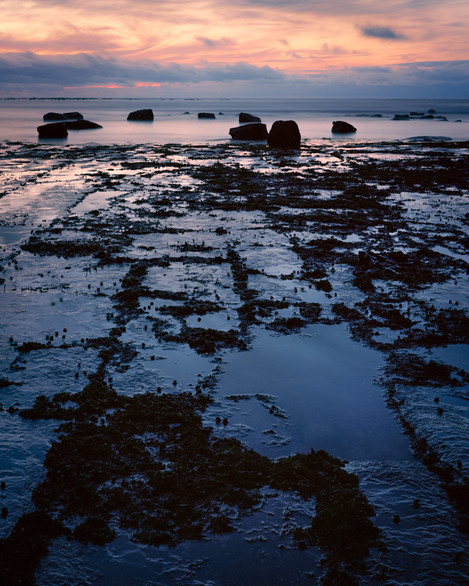Or a nice evening at the seaside ruined..

Tim Parkin
Tim Parkin is a British landscape photographer, writer, and editor best known as the co-founder of On Landscape magazine, where he explores the art and practice of photographing the natural world. His work is thoughtful and carefully crafted, often focusing on subtle details and quiet moments in the landscape rather than dramatic vistas. Alongside his photography and writing, he co-founded the Natural Landscape Photography Awards, serves as a judge for other international competitions. Through all these projects, Parkin has become a respected and influential voice in contemporary landscape photography.
Around midsummer Joe Cornish, David Tolcher, Andrew Nadolski and I decided we'd set ourselves a little challenge to turn up at the same location with a bunch of cameras and see what happened. As David Tolcher has a house in Robin Hood Bay we chose Saltwick Nab as a great location as the sun sets off to sea in the North at this time of year (well - North West obviously but that's up the coast in these parts).
Each of us had about three hours to take a look around and to explore the slate bed just offshore where the wreck of the Admiral von Tromp sits alongside reflecting pools and the graphic outline of Saltwick Nab.
Read about our experiences below..
Joe Cornish
When you have visited somewhere countless times before, the main challenge would appear to be, how do I not repeat myself? In fact, the North Yorkshire coast shorelines are so dynamic that literally repeating oneself is virtually impossible. Even Saltwick's giant sandstone blocks that I know well from the western side of the beach seemed to have been upturned and repositioned in the winter storms. The sea stacks, Saltwick Nab, and Black Nab seemed familiar enough, but all the details on the beach seemed different.
Our predictions for the falling tide proved errant as well which, sort of, scuppered our plans.
If landscape photography is a half-remembered echo of hunter-gathering, as some wise heads have speculated, then adaptability, and a willingness to seek other opportunities seems a consistent tactic. I imagine that, if hunting woolly mammoth in the lowlands where the North Sea now resides, our ancestors were not deterred if their preferred target had sought pastures new (for example, to the relatively high land of the modern-day Netherlands). They would by necessity have sought some other prey, or else had to face hunger, or worse. We are more fortunate, but the obligation to be resourceful remains.
Anyway, back to June 2014 in North Yorkshire…! With the limited beach available, and the light flat under the predominantly cloudy sky, detail seemed the most productive theme to pursue. Like Tim, I found myself drawn to the cliff itself with its predominantly dark, shaley sediments broken by clean fractures, fissures and seeps of bright orange, where iron has leached from the rock. My first image is almost completely two dimensional, and depends on contrasting colour relationships and subtle damp textures to give it life. Made on a fairly new Phase One IQ 280 with a Hasselblad 503 CW (20 years old) a Zeiss 120mm Makro (30 years old).
The kelp beds that lie just offshore had been recently scoured; a large area of the sandy part of the beach was caked in it. My instinct initially was to avoid the kelp, but one large hank of weed lay isolated from others. On closer scrutiny its shape took on the form of a resting animal, a dog perhaps, with a menacing presence to the shape, especially when approached from a low angle and in such gloomy light. Echoes of Cerberus, the mythical protector of the Underworld (I must wean myself off the aspirin…). Such a low angle and such near-far elements would challenge the depth of field capabilities of a conventional camera. Accordingly I selected a hybrid arrangement of 40mm Hasselblad lens and Nikon D-800 on a Mirex tilting converter. This combination gives amazing depth of field control with a natural perspective and wonderful image quality. A shame the lens is so huge! In such dark conditions with the light-sapping textures of kelp, a Lee ND 0.9 grad was also needed to feather back the sky.
It seemed that the with the sun now long since set that our time was up. But as we chatted for a few minutes the tide finally retreated enough to reveal the amazing rock platform that makes Saltwick such a wonder for photography. We agreed to continue. My final effort is far from an original idea, but with very little experience of painting with light it was, for me, a useful exercise. Much gratitude to Dave Tolcher for the loan of head torch!
David Tolcher
It all started so well – the planning was good, weekend organised, tides favourable and weather forecast optimistic despite the cloudy high that had settled over the UK.
We gathered at Robin Hoods Bay and had a good round of fish & chips washed down with some Timothy Taylors ale in the Grosvenor setting a good foundation for an evening on the beach. Even the sun was peeking out over the sea under the blanket of gloom, maybe Saltwick was going to work some of its magic tonight.
Saltwick is one of the few places on the East coast that the sun sets over the sea for about 6 weeks during late May, June and first part of July. It is a well known location with an interesting wreck, Victorian industrial architecture, good beach geology and a sea stack. The predominant rock formation is Jurassic Lias which is shiny black when wet (and very very slippery) going to dull grey when dry. Ironstone seepage has stained some areas with vibrant flows of red, white and orange. Areas of Middle Jurassic sandstone with banding and black plant debris cap the cliffs and can be found littering the beach from old falls. A lot happening in quite a small area but actually quite hard to work images from.
Sunset is late around mid summer and the afterglow goes on and on so you can be taking photographs well past 11pm if conditions are right. A receding tide is crucial for the best images at Saltwick so that the rocks (and shelves) are wet and very reflective. We had high tide at 18:45 which was a bit later than perfect but the sea should be out over the first reef exposing the stepping stones for about 21:30. Sunset at just before 22:00.
What could possibly go wrong?
We arrived at the car park around 20:00 and were somewhat surprised to only see water from the cliff top. It soon became obvious that the tide wasn’t receding as fast as expected. Spring tides was one factor but a bitingly cold Easterly wind was keeping the water in. Speaking to a local fisherman who was also caught out by the conditions he reckoned that it was as much as ½ an hour behind where it should be based on the onshore breeze. This was to become crucial after sunset in that we couldn’t get on to the areas we needed until after the light had gone.
N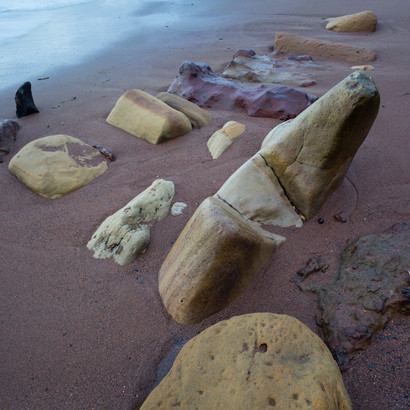 evertheless we pressed on. Although I know Saltwick well having collected fossils there for nearly 40 years and taking pictures since the late 1990s it is somewhere that I always find difficult to get your eye in when the conditions are less than perfect. The temptation is to return to old favourites, search out some well loved bits of sandstone or old jetty or cliff. The high cliffs unbalance any image that includes them, they are dark rock and mostly in shade. Working under them is slightly hazardous (especially recently as cliff ‘showers’ and falls have been more frequent since the 2013/14 Winter) but can be rewarding. I had a new Samyang 24mm F1.4 lens in the bag that I wanted to try on the A7R and found an image that would serve that purpose.
evertheless we pressed on. Although I know Saltwick well having collected fossils there for nearly 40 years and taking pictures since the late 1990s it is somewhere that I always find difficult to get your eye in when the conditions are less than perfect. The temptation is to return to old favourites, search out some well loved bits of sandstone or old jetty or cliff. The high cliffs unbalance any image that includes them, they are dark rock and mostly in shade. Working under them is slightly hazardous (especially recently as cliff ‘showers’ and falls have been more frequent since the 2013/14 Winter) but can be rewarding. I had a new Samyang 24mm F1.4 lens in the bag that I wanted to try on the A7R and found an image that would serve that purpose.
Catastrophe – open the bag and there is the empty space where the camera should be. This is a new problem with mirrorless… too damn light, this would never have happened with Large Format or even my old Nikon DSLRs. I had taken the A7R and pancake lens out with me on a walk and left it at home in the pouch of my jacket. I had turned up on location with a bag full of lenses and no camera and no back up. You visualise that image of a donkey all too well at this time especially with the sniggers from your friends and the ‘been there, done that’ comments. Fortunately Joe had an A7R in the van which he kindly yomped up the cliff to get for me. It was going to be one of those nights !
First image if of some of the sandstone blocks in the predominantly orange sticky sand that is found on the beach. I was attracted to the reflected light on the sand from the blue sky out over the sea in the shade of the cliffs. The scene had a heavy tranquillity to it and good modelling leading to a perceived 3D image. I really needed a bit more height but could just get separation by standing on a rock. Image is a 3 image stitch taken at F16 on a Mirex adapter and 35mm PC Distagon.
As the tide receded we moved down towards the Nab and wreck at the Southerly end of the beach. An opportunity to test the 24mm lens presented itself with the newly exposed wall of the old quay. Interesting cloud and a blue soft light again from the blue sky out over the North Sea. A combination of 2 stop ND grad and 3 stop pro glass ND filter gave me a good shutter speed to soften the sea. It was very important that the sea had just receded as the quay is very dull once dry and sucks away light more effectively than any black hole.
The afternoon high tide had moved a large amount of kelp on to the beach and left it in strands over the sand. The soft light and glowing greens of the waterfall caught my eye as something a bit unusual – the quality of light can be very good at Saltwick and lift an ordinary scene into something a bit more interesting. Again a 3 stitch pano with the PC Distagon stopped down to F16 gave me something I was happy with.
At last the tide was going out. Unfortunately the cloud had closed the gap in the sky that we had hoped would provide a few moments of magic but the light was soft and tranquil. As the sea moves beyond the first reef it briefly leaves a pool of water through which the stepping stones emerge. These aren’t really stepping stones but a series of flat rocks from a hard layer in the cliffs. I really wanted to capture the tranquillity of the scene with space for the very soft sky. Timing of the exposure was key to avoid the fisherman and his headtorch looking for ‘peeler’ crabs around the Nab. Shot times on the 24mm lens stopped down were over 10seconds now and very very blue ! A switch to ‘cloudy’ white balance and a slight warming of the image and magenta hue adjustment gave the final result.
I was pleased with my four very different images from 3 hours at Saltwick. Note to self – always check the camera is in the bag!
Lastly an image taken partly with my headtorch of Joe at work in the twilight
Andrew Nadolski
Wow - talk about being thrown into the deep end; physically and metaphorically. When I left Exeter for the seven hour drive to Robin Hood’s Bay for an OnLandscape management meeting it was definitely shorts and t-shirt weather and that is exactly what I packed; alongside my Sony A7R with 35 and 55mm lenses and tripod.
The decision was made that on the Saturday evening we should all go off for a joint dusk shoot at Saltwick Bay. Mr Tolcher, with a beady eye on the tide times, told us that we had time for a relaxed meal (accompanied by an excellent pint of Landlord) in the local pub before heading off to the beach.
When we got to Saltwick the situation became even more absurd in that the beach was almost completely covered with water and the promised receding tide looked like it wasn’t going to be doing a lot of receding this side of midnight. With an onshore wind the words ‘slightly chilly’ sprang to mind. Oh well I thought if I didn’t come back with any good images I would be able to invent a whole new genre of landscape photography - UCS - Unintentional Camera Shivering - but that would just be a load of bollocks wouldn’t it.
I offered to express my artistic reactions to Saltwick through the medium of dance but the others weren’t having any of that. Mind you I thought it a little unfair as David was obviously intending to use mime as his medium of expression having forgotten his camera!
This is where the metaphorical deep end comes in. It is a little daunting to go to a location that others know well and feel pressured to produce something to display.
I pottered around a little trying to make a few compositions with the wet sand and sea but struggled with a sinking tripod. I knew later on I would be able to produce something ‘acceptable’ at the very least; as water, dusk, long exposure = picture; not exactly original. Would I be able to produce anything meaningful, an artistic reaction to a place? Highly unlikely as there wasn’t time to sit, watch, absorb and simply feel the landscape. I need to walk and look before I can consider getting my camera out.
Is it possible to produce images that ‘say’ something when you haven’t worked out what you might ‘feel’ about a place? The path of compositional cliches is all too easy to go down, making ‘paint by numbers’ images from artistic ‘devices’ - rule of thirds, s-shaped curves etc etc. This trap is readily sprung for all who call themselves ‘landscape photographers’.
We are in an age where it has never been easier to take a photograph but never been harder to take a good photograph. Are we all ‘chasing the light’, tracking down the light’, nay ‘shagging the light’? Has landscape photography become the new big game hunting - tracking down the trophy image at the expense of any intellectual depth or genuine emotional response?
I wonder if there are simply too many landscape photographs ‘out there’ and I am afraid that is the blessing and the curse of the internet - often there is no editing; technicolour images are vomited onto the pages of Flickr and popularity with ‘likes’ and ‘re-tweeting’ seen as success in some kind of eworld of mutual self congratulation. ‘Following’ each other’s blogs or Facebook posts like an ever decreasing circle of dogs sniffing each others delicate parts.
Now I think I had better climb down off my soapbox before I am pushed off.
Anyway my reactions to Saltwick - looks like it might be an interesting place - I have even been told there is the wreck of a boat that makes for good pictures....
Tim Parkin
It's true that I've been to Saltwick a couple of times in the past and so I should have a small idea what to expect but both times I've been led by our resident expert David Tolcher to just the right spot for reflections, Nab and sunset and hence didn't really get much chance to explore the rest of the bay. Tonight it turned out I'd have even less chance as fortune threw an extra challenge in the guise of a foot of salt water obscuring most of the aforementioned beauty spots.
However, this is part of the idea of the article - in the real world what can you make out of a location given a single evening? Well in my case I fancied taking a look at the opposite end of the beach from the main attraction and was immediately struck by the textures of the mineral stained sandstone and mudstone in the cliff face. The minerals, probably predominantly the famous 'Alum' which was used in antiquity to fix dyes, had dripped across the rocks and dried, sometimes to a rich yellow or orange and sometimes as a white, talcy veil. For my purposes it created all kinds of variety and my task was to make some sense of them as a composition.
The surface of the cliff was three dimensional enough that this wasn't just a case of 'cropping' a nice pattern and so I used a framing card (a 4x5 hole in a piece of black plastic) whilst wandering around to try to find appropriate shapes. A suitable pattern stood out quite quickly and, thankfully, I didn't have to get too close to the cliff (which has a tendency to rockfalls on a regular basis). My camera of choice was my Ebony 45SU large format camera and with a little bit of swing and tilt I got my plane of focus in the right place. A final adjustment for bellows factor and hopefully Fuji Velvia would do the rest.
I continued looking for a few moments wondering if anything else would catch my eye and within about ten foot of the first composition another possibility appeared. I was hoping to move on and try some different subject matter but being as I'd got my eye in on this type of subject and my camera was already out I gave it another shot. This needed a much longer lens - I was using a 360mm lens and area of interest was only about 14 inches across. Lots of bellows and a steady hand and that was two shots in the bag.
Having captured a couple of shots I was reasonably happy with it was time to wander around looking for something else. As has been mentioned, our only disadvantage was the onshore wind that kept that seawater blocking our access to the fun stuff. However, instead of trying to hard I took the opportunity to have a chat with a local fisherman who was stocking up on peelers for his bait (crabs that have just shed their shell) and he told me about how the tides work locally, the pertinent bit being up to a fifty minute delay if there is an onshore wind and a low pressure (which we had). It looked like a view of the wreck at sunset wasn't going to happen.
To add insult to injury the dreaded 'Middlesborough Wall of Cloud' made it's regular appearance and blocked any hope of a sunset or afterglow. Having only made a couple of exposures I felt I had to at least try for one more and so I saw a few rocks just offshore and a hint of parallel lines in the slate in the foreground and so I checked the meter to see what exposure I'd need on Portra 400 - well two minutes wasn't so bad. focussing when you can't see s**t wasn't so much fun. I used a headlight to illuminate the foreground whilst applying tilt and crossed my fingers.
Unlike my digital brethren I didn't get to share the product of my work until the following week when I stocked up with C41 and E6 developer. I then had the wonderful experience of wondering if my exposures were right and if my chemicals were mixed correctly. It all worked out OK though and with a quick run through the drum scanner I got to show my off my own results (a week after everybody else's of course!)
Conclusion
The whole 'challenge' was interesting. I was impressed at how differently we all saw the location and opportunity. I think in many ways having slightly poor conditions was more interesting for the article. We ended up having to work harder to find photographs and to work with the conditions.
I hope you've found the results interesting - we plan to repeat the exercise at some point in the future in another location with different people perhaps.
Featured Comments From:
Ian: It is interesting how different the results of the trip were for each participant. Very brave of Andrew to head out to the NE coast in just a t-shirt, even if it is summer (allegedly). I’ve only been to Saltwick once and the wind was really cutting on that occasion too.
I also enjoyed Andrew’s soap box mini-rant and wonder if there would be any value in an expanded discussion on the assertion that “We are in an age where it has never been easier to take a photograph but never been harder to take a good photograph”.
David O'Brien: This seems a bit like 3 men in a boat! a great read and on any future trips please bring Mr Nadolski and his soap box. I was sitting in the infernal Quiet carriage on the train when I collapsed in laughter at the phrase “shagging the light”. Am not sure my fellow passengers are pleased with me.

